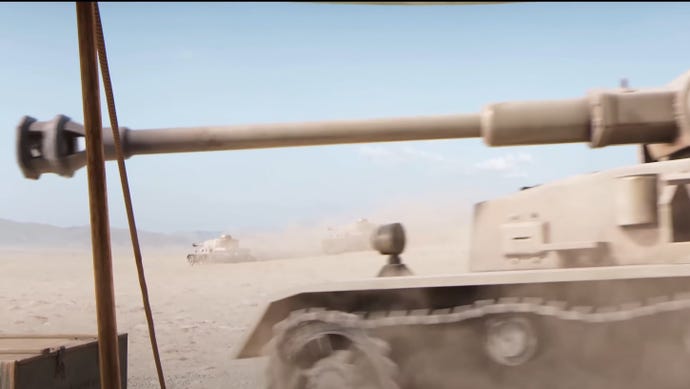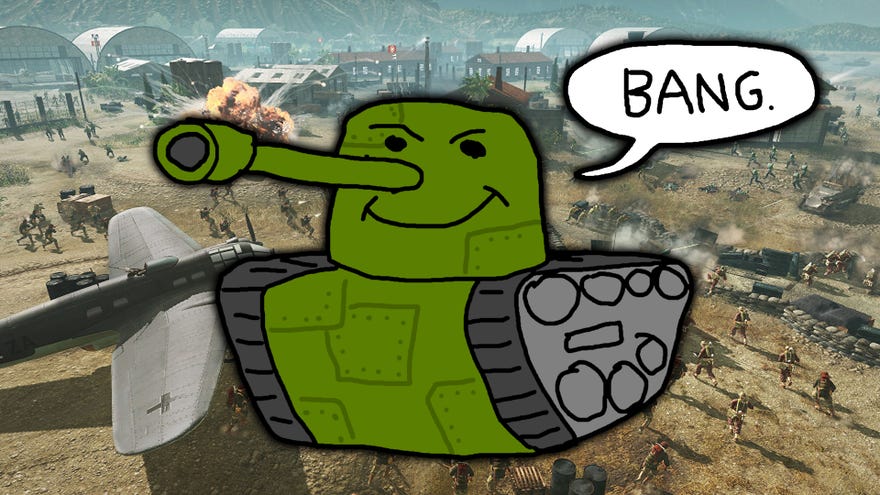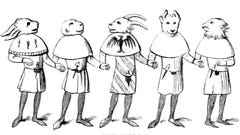Company Of Heroes 3 devs talk janky tanks, motorbikes, and a mysterious super-heavy oddball
Actually, the scientist was called Tankenstein
Ever since the pixellated rectangles of Dune 2 trundled into my world back in the early 90s, I’ve had a soft spot for tanks. I must have commanded millions over the last three decades of real time strategy, but in all that time they’ve not really changed much. A video game tank in 2021 might have a damage-reducing armour value, but it’s still essentially a box that snarls “yessir” when you click on it, and which functions perfectly until its hit points run out, whereupon it bursts. I want more complexity. I want tanks which feel like the messy, complex, cantankerous machines they are. And while there are many games which go well deep into simulating tanks, they’re largely not RTS games.
Among the extant tank-havers of the RTS genre, it’s probably Company Of Heroes 2 which lends the big metal lads the most personality. It makes Panzer Vs every bit the icons of fear they should be, while T-34s career about the place like the reckless, clattering have-a-go heroes they were. When Company Of Heroes 3 lands next year, we’ve been promised an even chuggier time, so I had a chat with the game's lead campaign director Andrew Deneault and lead mission designer Sacha Narine to find out more about what to expect.
Having heard that CoH2 was going to play more like the original Company Of Heroes than its direct predecessor, with a heavier focus on infantry, I had assumed it would come with a smaller dose of Vitamin T. Thankfully, this isn't the case. What Relic actually meant by this was that the rhythm of a typical game has been tweaked so the early, infantry-heavy phase of the game simply lasts a bit longer before the heavy metal arms race begins.
Nevertheless, there are still loads and loads of tanksin Company Of Heroes 3. Deneault told met he game will feature around three times the number of vehicles present in CoH2, which was already a decent roster at 35-odd. Commensurate with the slower acceleration of a typical match, a big slice of the new stuff comprises light vehicles, which bridge the gap nicely between infantry-only skirmishes, and monstrous land-battleship slugfests. There are lots more armoured cars and halftracks on the table now, as well as real featherweight assets like jeeps and motorbikes. Lovely stuff.

This is a welcome development, for sure. While I wouldn’t pretend to be on top of the CoH2 meta, my game plan has always tended towards an initial push to seize resources with infantry, who will then be tasked with hanging on for dear life while I hoard enough resources to get out the Big Lads.
By contrast, in my CoH3 games so far, I've found myself mixing way more light vehicles into my force composition from a much earlier stage of play. There were plenty more available, for a start. But more importantly, they were realistically affordable after just a couple of minutes in-game. At times, CoH2 felt like being stuck as a renter in the London property market: the really good stuff often felt unreasonably expensive, and I seemed to spend ages just waiting to be able to afford things. In CoH3, however, treating yourself to a jeep is a perfectly valid option while opening a game, and offers a satisfying sense of variety.
And of course, as I mentioned in my Company Of Heroes 3 preview, I already fell in love with the Stuart light tank, a cheap little fellow with a rapid-firing weapon, which can realistically be deployed in small squadrons much earlier than I’d usually expect in a CoH match.
“It was a great tank,” Deneault agrees. “It was really well serviced, and so many nations used it. It absolutely should be a first choice for any player at the start of a match - whatever the situation, it’s usually a great buy.”

So: more light vehicles. But also, more weird vehicles. Given that the Italian campaign CoH is set during, as Deneault calls it, an “experimental phase” of the war, there were some oddities around at the time, many of which have ended up in the game. Deneault’s favourite is the ‘WhizBang’, a variant of the American M4 Sherman which had a big square rocket launcher welded to the top of its turret, making it look like a Beano drawing of a teacher. It’s one of the vehicle call-ins made available if playing as a US special ops company, and after having a go with it, it’s possibly my favourite as well, now.
“I think the Brits have perhaps the wildest heavy tank”, says Narine, “but I’m not sure we’re allowed to talk about it right now”. I wanted to probe more as to what this wild tank could be, but we accidentally spent ten minutes discussing the pure horror of the “crocodile” variant of the Churchill tank, which could project torrents of hellish burning fuel more than 100 metres. Genuinely terrifying.
CoH3 features a more realistically modelled armour system for tanks, building on the front/back values of CoH2, and I was keen to know what other enhancements were being made for the sake of fidelity. In an ideal world, I’d love to see RTS tanks just as varied, idiosyncratic and unpredictable as the real machines they’re based on.
"If we represented the fact that an Elefant tank destroyer could only travel at eleven miles per hour, or tended to constantly sink into the ground because it weighed 65 tons, it wouldn’t be a lot of fun to use."
“We do rein in some of the historical flaws associated with vehicles,” admits Narine. “For example, if we represented the fact that an Elefant tank destroyer could only travel at 11 miles per hour, or tended to constantly sink into the ground because it weighed 65 tons, it wouldn’t be a lot of fun to use.”
Nevertheless, he continues, there’s no intention to clean up all the mess. Following on from the Critical Hit feature in CoH2, Relic continue to be interested in alternatives to the traditional tendency of RTS units to exist in a binary state between being intact, and being annihilated. They’ve been thinking about so-called “mobility kills”, for example, wherein damage to treads or transmission would immobilise a tank but leave its gun operable. And the opposite situation, of course, wherein a gun might jam but leave a tank capable of moving and drawing fire from more vulnerable units.
It’s these sorts of features that, deep down, really get me excited about strategy games. Unpredictability is always welcome to me, as it can force me to improvise my way out of a previously stable situation. As such, while I’m excited for CoH3’s collection of tanks, I’ve got a fair emotional investment in their level of jank, too.


















